Saṃsāra is a Pali and Sanskrit word that means "wandering" as well as "world," wherein the term connotes "cyclic change" or, less formally, "running around in circles." Saṃsāra is referred to with terms or phrases such as transmigration/reincarnation, karmic cycle, or Punarjanman, and "cycle of aimless drifting, wandering or mundane existence". When related to the theory of karma it is the cycle of death and rebirth.
Bhavachakra describing the cycle of saṃsāra: illustrated in the wheel are six realms of existence in which a sentient being can reincarnate, according to the rebirth doctrine of Buddhism. Yama, the god of death, is at the top of the outer rim. The outer rim shows the Twelve Nidānas doctrine.
Symbolic depiction of saṃsāra at Shri Mahaveerji temple of Jainism.
Traditional Tibetan thangka showing the bhavacakra and six realms of saṃsāra in Buddhist cosmology.
Image: Meerabai (crop)
Reincarnation, also known as rebirth or transmigration, is the philosophical or religious concept that the non-physical essence of a living being begins a new life in a different physical form or body after biological death. In most beliefs involving reincarnation, the soul of a human being is immortal and does not disperse after the physical body has perished. Upon death, the soul merely becomes transmigrated into a newborn baby or an animal to continue its immortality. The term transmigration means the passing of a soul from one body to another after death.
Illustration of reincarnation in Hindu art.
In Jainism, a soul travels to any one of the four states of existence after death depending on its karmas.
A second-century Roman sarcophagus shows the mythology and symbolism of the Orphic and Dionysiac Mystery schools. Orpheus plays his lyre to the left.
American psychologist and philosopher William James (1842–1910) was an early psychical researcher.








